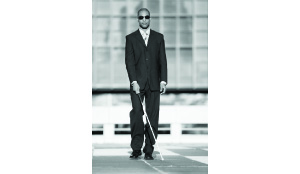BY JOWIT SALUSEKI –
“BECAUSE of poor signage on the Zambian roads for motorists, which in most cases are non-existent, most visually impaired people are finding it difficult crossing the roads”.
These were the words of Felix Silwimba, director general of the Zambia Association of Persons with Disabilities (ZAPD).
According to Dr Silwimba, the Road Transport and Safety Agency (RTSA) and the Road Development Agency (RDA) have not been considerate enough when designing road signage, hence most visually impaired people’s lives are exposed to danger when crossing busy roads.
He said apart from traffic lights not being fixed with beeping sound gadgets, which can alert visually impaired persons as to when to walk or stop at traffic junctions, for example, there are no markings on roads to indicate which side of the road wheel chair users can apply.
“Even with traffic lights, there is need for them to have a beeping sound which can imply that a visually impaired person moves or stops. Wheel chair users must also have their designated side of the road with clearly marked signage therefore, RTSA and other relevant authorities should seriously look into these issues,” he said.
Dr Silwimba said the media should also be highlighting such challenges faced by disabled people who are finding it difficult to move safely on the road.
“We are not after negative reporting all the time but positive reporting so that relevant authorities will be able to know about the challenges being faced by disabled people,” he said.
He said in some countries where the cane guide or white stick which has been recognised as a safety measure on the roads, statistics indicate that there has been a reduction on road carnages involving visually impaired people crossing highways.
He explained that essentially, a visually impaired person is supposed to move with a dog guide, a white stick and also wear a standard reflector for easy identification when walking on the road.
Unfortunately most visually impaired persons in Zambia don’t move with white sticks as most of them depend on family members and well wishers to guide their movements on the road.
John Musonda,70, a visually impaired of Lusaka’s Misisi Township, said he depends on his grandson to guide him to cross the road safely.
“It is very difficulty for me to cross safely on most of these busy roads like Cairo or Kafue roads without the help of my grandson,” Mr Musonda said, who normally begs for alms under the Kamwala footbridge.
Elinati Tembo of Zingalume Township also depends on her 10-year-old daughter to aid her movements on the roads.
Unfortunately, her daughter who is supposed to be in grade two has even stopped attending classes.
Similar sentiments of challenges faced by visually impaired people when crossing the road were expressed by Clementina Soko, 62, of Lusaka’s Linda Township.
As a safety measure on the road, in some countries, most visually impaired people use the guide cane.
The guide cane or white stick as it is commonly called is used by visually impaired people to aid their movements on the road.
In 1921 James Biggs, a photographer from Bristol in United Kingdom was having difficult dealing with his walking stick and then decided to paint it white so that he would be more visible to traffic.
Gully d ’Herbermont launched the national white stick movement for the visually impaired people in 1931 in France while George Bingham introduced the White Cane in the US.
Bingham was a member of the Lions Clubs International and it was in 1930 when one of the members of the Lions Club saw a visually impaired man crossing the street with a black cane that was barely visible to anyone driving on the road.
The Lion’s Club then painted his stick white and began to promote white walking sticks for the visually impaired.
Dr Silwimba expressed concern that with an increase in carnages occurring on the roads in the country, most visually impaired people’s lives, adding that RTSA should also be recording the number of visually impaired people who die whilet crossing the road.
“In other countries, persons with disabilities belong to strong organisations and when a member dies, they are able to take stock of their deceased members, unfortunately in Zambia, people who capture data on road carnages are always highlighting the dead and not focusing or mentioning the number of disabled peopled who are killed,” he said.
He noted that there could also be possibilities that people with hearing impairment have also lost lives after being hit on the roads by vehicles that produce low sound due to modern technology.
“In the past, most vehicles were noisy but due to advancement in technology, some cars that are being manufactured have low sound such that you can hardly tell that there is an oncoming car and by the time you realise you are bashed,” Dr Silwimba said.
RTSA director Zindaba Soko, recently stated that the agency had recorded 400 fatalities out of 7,767 road traffic accidents in the first quarter of the year.
It is only hoped that the Government through relevant authorities mandated with road safety, will be able to look into the plight of the visually impaired with regards to road signage in order to ease their movement on the road.







